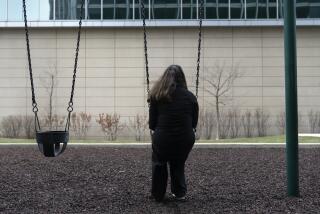For Teens, Bloom of Youth Isn’t So Rosy
- Share via
STONY BROOK, N.Y. — Dr. Robin McFee, who teaches a course in adolescent health to medical students at State University of New York, Stony Brook, points out an interesting paradox: While adolescence is the time of greatest “inherent health,” the overall health of adolescents, unlike other age groups, has declined during the past several decades.
The reason for this is that the years from age 10 to the early 20s are a time marked by a tendency to engage in risky behavior with serious consequences. About three-quarters of deaths among 10- to 24-year-olds in the United States are caused by car crashes (29%), murders (20%), suicides (12%), and unintentional acts such as drowning or poisoning (11%), according to the national Centers for Disease Control and Prevention.
Although the unintentional pregnancy rate among American teens has dropped slightly in the past several years, it is still among the highest in the world. And every year, 3 million teens--about one in four who are sexually active--get a sexually transmitted disease.
About 5% of adolescent females have a full-blown eating disorder, according to the Society for Adolescent Medicine; the percentage with some form of eating disorder is much higher.
According to the CDC, more than one-third of high school students are smokers, and college-age smoking also has risen dramatically.
And a 1997 CDC survey found that close to 40% of high school students had ridden in the previous 30 days with a driver who had been drinking alcohol. The National Institute on Drug Abuse reports that in the class of 1997, more than half had used an illegal drug.
*
Despite the prevalence of risky behavior and despite the lip service paid to preventive medicine, adolescents are among the most underserved groups medically. Although adolescents represent 17% of the U.S. population, they represent only 11% of medical visits, and less than 20% receive routine or preventive care annually, according to the National Adolescent Health Information Center at UC San Francisco. About 15% of adolescents have no health insurance at all.
Part of the reason adolescents don’t go to the doctor is that many are uncomfortable with the doctor who took care of them as babies and toddlers. And, experts say, while pediatricians have the technical expertise for medical problems, some may be uncomfortable with the psychosocial issues that dealing with teens presents.
“There’s a big hole between pediatrics and internal medicine,” said Dr. Deborah Saunders, an adolescent medicine specialist in Rockville Centre, N.Y. “You need to find someone who enjoys working with adolescents and is willing to take the time and listen to his or her concerns in a private session without the parents.”
But adolescent medicine as a specialty is still coming of age. Dr. Martin Fisher, president of the American Society for Adolescent Medicine, said there are 1,000 doctors in the society, about 300 of whom have been board-certified in adolescent medicine. “Clearly there are not enough people for every adolescent to see an adolescent-medicine doctor,” said Fisher, chief of the division of adolescent medicine at North Shore University Hospital in Manhasset, N.Y.
More important, he said, is finding a doctor, regardless of the specialty, who “knows what the issues are and will open the avenue of discussion.”
But McFee said that many doctors are unaware of these issues: According to McFee, only 33% of visits to doctors included counseling recommendations from the Guidelines for Adolescent Preventive Services, a program developed by the American Medical Assn. and backed by the American Academy of Pediatrics and Society for Adolescent Medicine.
*
Yet, doctors can be important, nonjudgmental sources of information for kids unable or unwilling to ask their parents for information or help, she said.
Fisher said parents should ask their child’s pediatrician or family doctor if he or she feels comfortable dealing with their adolescent; conversely, the child should be asked if he or she feels comfortable with the doctor. If not, look for another doctor, he said. The key is to find someone the adolescent can trust and talk to “before there’s a crisis,” Fisher said.






